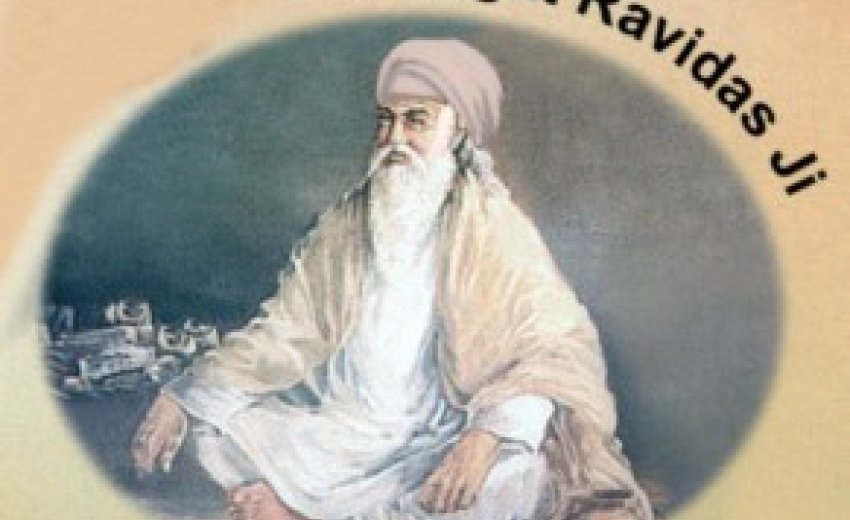Historic Details and Discrepancies
| Bhagat Ravidas 15th Century Poet (1376 AD - 1540 AD) |
|
Bhagat Ravidas, a 15th century poet of Hindu origin, is one of the authors of Guru Granth Sahib, with 41, of his 240 compositions, included in the Sikh scripture. Born to the lowest caste whose oppressed poor revered him as a saint, the upper caste Brahmin priests disdained him for his fame and complained to the nobility, however he ultimately earned the respect of regents and rulers, who turned to him for spiritual guidance and enlightenment. Bhagat Ravidas wrote of rank and class as having no place in the ultimate scheme of life for one concerned with spirituality:
Taerae mitteh paap sabh kott kott || your sins shall be totally erased though they be millions upon millions. Keh ravidaas juo japai naam || Says Ravi Daas, whosoever utters the name, Tis jaat na janam na jon kaam ||4||1|| that one has no concern with social class, birth, or rebirth." ||4||1|| SGGS||1196 Many legends abound surrounding the birth, life, and death of the 15th century poet. Obscure historic details shrouded by the passage of centuries are blurred with discrepancies offering multiple possibilities regarding names, dates, and places. Bhagat Ravi Das is the name attributed to the poet by his own writings in the scripture of Guru Granth Sahib. He also known throughout history by the names, Raidas, Rohidas, or Ruhidas. He is sometimes referred to as 'Guru' Ravidas, in the sense of having been an illustrious teacher of his time, who continues to have a modern day following among India's lower classes who consider the "untouchable" saint to be their champion. The parents of Bhagat Ravidas also have more than one name attributed to them. His mother and his father are known by several names. Possibilities include Mata Kalsa, or Khalsi wife of Baba Santokh Das a Sarpanch (clan headman) under the rule of Raja Nagar Mal, and Dhurbina, Ghurbinia, or Karma Devi, wife of Mann Das, or Raghu. The family belonged to the Shudra untouchable Hindu Kutbandhla Chamar caste of leather workers. The birthplace of Bhagat Ravidas is believed to be Seer Govardhanpur nearby the larger city of Bannaarsee, or Varanasi which is also known by the names Banares / Banares, or Kashi / Kanshi and is located in the modern day state of Uttar Pradesh, of North India. The birth of Bhagat Ravidas is believed to have occurred most likely in the month of Magh on the 14th day Sudi (waxing moon) during Pooranmashi (full moon), Vikram Samvat (SV) 1456 corresponding to January 30, 1399 A.D., or SV year 1471 corresponding to February 3, 1414 A.D. The exact year is in question with possibilities ranging from the earliest dates of 1376, 7, or 8, A.D. According to the Nanakshahi Calendar, each year the birth of Bhagat Ravidas is observed on different dates during the month of February, often coinciding with the full moon. The parents of Ravidas arranged a marriage for him to Lona Devi. The couple married at a young age and had one son, Vijaydas. Ravidas left his parent's home and trade after the birth of his son, and began working on his own as a cobbler making and mending shoes. In early life Bhagat Ravidas studied with Bhagat Ramanand as the saint's disciple along with the bhagats Dhanna, Kabir, Pipa, and Sain. In later life, the humble cobbler Bhagat Ravidas had disciples of his own including Rajput royalty of Chittaurghar (Chitaur, Chittor), the poetess Rani Meera Bai (Mirabai), Maharani Jhalli Bai (Jalibai, Jalan, Jhally,) and her husband the Maharana. Bhagat Ravidas traveled to Punjab in the late 1400's where he met First Guru Nanak who at a young age admired and felt inspired by the hymns of the saint. Guru Nanak used investment money given to him by his father and purchase food for langar to feed Ravidas and other holymen. Ravidas also met with Guru Nanak later in Sultanpur near the River Bein. The two met again in 1498 A.D. at "Guru ka Bhag" a place of worship in Bannaarsee where the elderly Bhagat Ravidas agreed upon request to bestow manuscripts of his compositions to Guru Nanak. Many decades later, Fifth Guru Arjun Dev included 41 hymns bequeathed by Ravi Das composed in 16 various raags when compiling the Gurbani of Adi Granth. The lifespan of Bhagat Ravidas is thought to have covered over a century. Various *scholars and historians suggest that his lifetime ranged somewhere between 1376 A.D. and 1540 A.D., a 164 year period, with the most likely scenarios accepted as:
Bhagat Ravidas is believed to have completed his life in Varanasi. Legends exist which tell that no one witnessed his death, or discovered his body, but that only imprints of his footsteps remained. *Prithvi Singh Azad, Dr. Triloki Narain Dixit, Dr. Kulvant Kaur, Max Arthur Macauliffe, Prof. W.Hew McLeod, Bhagwat Vrat Mishra, Bhai Kahn (Kahan) Singh Nabha, Dr. Chandra Rai, Dr. D.P. Sharma, Harbans Singh, Dr. Joginder Singh, Nagender Nath Vasu, Ram Kumar Verma. |



 "Saadhoo kee jo laeh ott ||
If you seek the refuge of the holy
"Saadhoo kee jo laeh ott ||
If you seek the refuge of the holy